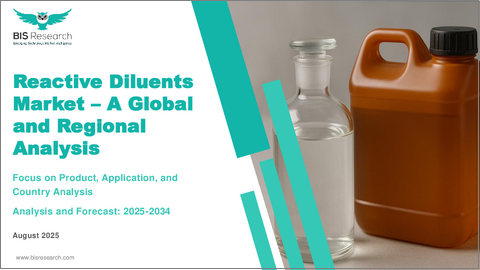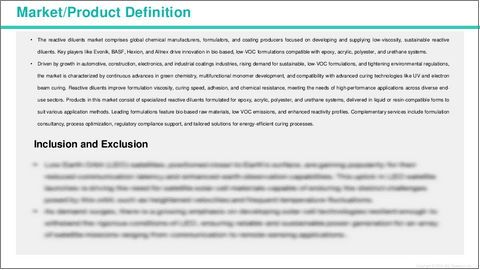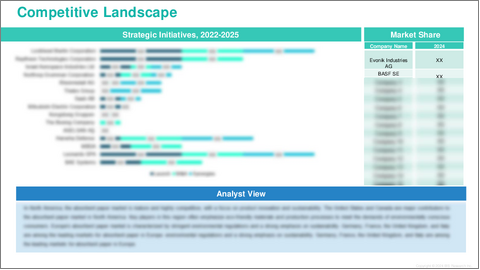|
|
市場調査レポート
商品コード
1795085
反応性希釈剤市場:製品・用途・国別の分析・予測 (2025-2034年)Reactive Diluents Market - A Global and Regional Analysis: Focus on Product, Application, and Country Analysis - Analysis and Forecast, 2025-2034 |
||||||
カスタマイズ可能
|
|||||||
| 反応性希釈剤市場:製品・用途・国別の分析・予測 (2025-2034年) |
|
出版日: 2025年08月21日
発行: BIS Research
ページ情報: 英文 120 Pages
納期: 1~5営業日
|
全表示
- 概要
- 図表
- 目次
反応性希釈剤の市場は、塗料、接着剤、複合材料産業において重要な役割を担っており、施工効率を高め、最終製品の耐久性を向上させる低粘度で高性能な配合への需要を支えています。
世界的に揮発性有機化合物 (VOC) 排出規制が強化され、環境政策による持続可能性目標の加速、環境に優しい製品への消費者需要の高まり、高分子化学の進歩が進む中、環境負荷を低減しつつ硬化性や機械的特性を向上させる革新的な反応性希釈剤の必要性がますます高まっています。
この業界は、バイオベースの低VOC反応性希釈剤の開発や硬化効率の改善を目指した継続的な技術革新によって特徴づけられています。主要メーカーは、エポキシ系、アクリル系、ポリエステル系、ウレタン系の希釈剤を用いた革新を進めており、これにより硬化の高速化、接着性の向上、耐薬品性の強化を可能にしています。こうした進化は、REACH規制やEPAのVOC規制値といったより厳格な法規制によって後押しされており、持続可能な原料やクリーンな製造プロセスへの投資を促進しています。
| 主要市場統計 | |
|---|---|
| 予測期間 | 2025-2034年 |
| 2025年評価 | 12億3,000万米ドル |
| 2034年予測 | 21億3,000万米ドル |
| CAGR | 6.11% |
最新の反応性希釈剤技術は、ポリマーネットワークに化学的に組み込まれる多官能モノマーを利用しており、性能を損なうことなく粘度を低減します。イノベーションの例としては、再生可能な原料から得られるバイオベースの反応性希釈剤、耐傷性やUV安定性を高める多官能オリゴマー、UV硬化や電子線硬化といった先進的な硬化方法に対応した配合などがあります。これらの進歩により、自動車、建設、電子機器、工業用塗料といった分野で要求の厳しい用途要件を満たすことが可能となり、反応性希釈剤市場の需要を押し上げています。
持続可能性や規制遵守への重視が高まる中で、反応性希釈剤は塗料や接着剤製造における処方戦略の中心的存在となりつつあります。各企業は環境基準の変化に対応し、世界的なエコフレンドリーかつ効率的で耐久性のある材料への移行を支える、より環境負荷の少ない高性能希釈剤の開発に向けた研究開発に投資しており、この市場動向は今後も続くと予想されています。これらすべての要因が、予測期間を通じて反応性希釈剤市場の成長を後押しすると見込まれます。
反応性希釈剤の分類
セグメンテーション1:製品別
- 脂肪族
- 芳香族
- シクロ脂肪族
セグメンテーション2:用途別
- 塗料・コーティング
- 複合材料
- 接着剤・シーラント
- その他
セグメンテーション3:地域別
- 北米:米国、カナダ、メキシコ
- 欧州:ドイツ、フランス、イタリア、スペイン、英国、その他
- アジア太平洋地域:中国、日本、韓国、インド、その他
- その他地域:南米、中東・アフリカ
当レポートでは、世界の反応性希釈剤の市場を調査し、主要動向、市場影響因子の分析、法規制環境、技術・特許の分析、市場規模の推移・予測、各種区分・地域/主要国別の詳細分析、競合情勢、主要企業のプロファイルなどをまとめています。
目次
エグゼクティブサマリー
第1章 市場:業界展望
- 動向:現状と将来への影響評価
- 市場力学の概要
- 市場促進要因
- 市場抑制要因
- 市場機会
- 規制および政策影響分析
- 特許分析
- 世界価格分析
第2章 反応性希釈剤市場:製品別
- 脂肪族
- 芳香性
- 脂環式
第3章 反応性希釈剤市場:用途別
- 塗料・コーティング
- 複合材料
- 接着剤・シーラント
- その他
第4章 反応性希釈剤市場:地域別
- 反応性希釈剤市場:地域別
- 北米
- 地域概要
- 市場成長の原動力
- 市場課題
- 製品
- 用途
- 北米 (国別)
- 欧州
- 地域概要
- 市場成長の原動力
- 市場課題
- 製品
- 用途
- 欧州 (国別)
- アジア太平洋
- 地域概要
- 市場成長の原動力
- 市場課題
- 製品
- 用途
- アジア太平洋 (国別)
- その他の地域
- 地域概要
- 市場成長の原動力
- 市場課題
- 製品
- 用途
- その他の地域 (地域別)
第5章 市場:競合ベンチマーキングと企業プロファイル
- 次のフロンティア
- 地理的評価
- 企業プロファイル
- Olin Corporation
- SACHEM, Inc.
- Grasim Industries Limited
- Cardolite Corporation
- Cargill, Incorporated
- Guangdong Haohui New Material Co., Ltd.
- Evonik Industries AG
- Mitsubishi Chemical Group Corporation
- Nippon Kayaku Co., Ltd.
- BASF SE
- HUBEI PHOENIX CHEMICAL COMPANY
- KUKDO CHEMICALS
- ADITYA BIRLA CHEMICALS
- その他の主要企業
第6章 調査手法
List of Figures
- Figure 1: Reactive Diluents Market (by Scenario), $Million, 2025, 2028, and 2034
- Figure 2: Reactive Diluents Market (by Region), $Million, 2024, 2027, and 2034
- Figure 3: Reactive Diluents Market (by Application), $Million, 2024, 2028, and 2034
- Figure 4: Reactive Diluents Market (by Product), $Million, 2024, 2025, and 2034
- Figure 5: Competitive Landscape Snapshot
- Figure 6: Supply Chain Analysis
- Figure 7: Value Chain Analysis
- Figure 8: Patent Analysis (by Country), January 2021-June 2025
- Figure 9: Patent Analysis (by Company), January 2021-June 2025
- Figure 10: Impact Analysis of Market Navigating Factors, 2024-2034
- Figure 11: U.S. Reactive Diluents Market, $Million, 2024-2034
- Figure 12: Canada Reactive Diluents Market, $Million, 2024-2034
- Figure 13: Mexico Reactive Diluents Market, $Million, 2024-2034
- Figure 14: Germany Reactive Diluents Market, $Million, 2024-2034
- Figure 15: France Reactive Diluents Market, $Million, 2024-2034
- Figure 16: Italy Reactive Diluents Market, $Million, 2024-2034
- Figure 17: Spain Reactive Diluents Market, $Million, 2024-2034
- Figure 18: U.K. Reactive Diluents Market, $Million, 2024-2034
- Figure 19: Rest-of-Europe Reactive Diluents Market, $Million, 2024-2034
- Figure 20: China Reactive Diluents Market, $Million, 2024-2034
- Figure 21: Japan Reactive Diluents Market, $Million, 2024-2034
- Figure 22: India Reactive Diluents Market, $Million, 2024-2034
- Figure 23: South Korea Reactive Diluents Market, $Million, 2024-2034
- Figure 24: Rest-of-Asia-Pacific Reactive Diluents Market, $Million, 2024-2034
- Figure 25: South America Reactive Diluents Market, $Million, 2024-2034
- Figure 26: Middle East and Africa Reactive Diluents Market, $Million, 2024-2034
- Figure 27: Strategic Initiatives (by Company), 2021-2025
- Figure 28: Share of Strategic Initiatives, 2021-2025
- Figure 29: Data Triangulation
- Figure 30: Top-Down and Bottom-Up Approach
- Figure 31: Assumptions and Limitations
List of Tables
- Table 1: Market Snapshot
- Table 2: Opportunities across Region
- Table 3: Trends Overview
- Table 4: Reactive Diluents Market Pricing Forecast, 2024-2034
- Table 5: Application Summary (by Application)
- Table 6: Product Summary (by Product)
- Table 7: Reactive Diluents Market (by Region), $Million, 2024-2034
- Table 8: North America Reactive Diluents Market (by Application), $Million, 2024-2034
- Table 9: North America Reactive Diluents Market (by Product), $Million, 2024-2034
- Table 10: U.S. Reactive Diluents Market (by Application), $Million, 2024-2034
- Table 11: U.S. Reactive Diluents Market (by Product), $Million, 2024-2034
- Table 12: Canada Reactive Diluents Market (by Application), $Million, 2024-2034
- Table 13: Canada Reactive Diluents Market (by Product), $Million, 2024-2034
- Table 14: Mexico Reactive Diluents Market (by Application), $Million, 2024-2034
- Table 15: Mexico Reactive Diluents Market (by Product), $Million, 2024-2034
- Table 16: Europe Reactive Diluents Market (by Application), $Million, 2024-2034
- Table 17: Europe Reactive Diluents Market (by Product), $Million, 2024-2034
- Table 18: Germany Reactive Diluents Market (by Application), $Million, 2024-2034
- Table 19: Germany Reactive Diluents Market (by Product), $Million, 2024-2034
- Table 20: France Reactive Diluents Market (by Application), $Million, 2024-2034
- Table 21: France Reactive Diluents Market (by Product), $Million, 2024-2034
- Table 22: Italy Reactive Diluents Market (by Application), $Million, 2024-2034
- Table 23: Italy Reactive Diluents Market (by Product), $Million, 2024-2034
- Table 24: Spain Reactive Diluents Market (by Application), $Million, 2024-2034
- Table 25: Spain Reactive Diluents Market (by Product), $Million, 2024-2034
- Table 26: U.K. Reactive Diluents Market (by Application), $Million, 2024-2034
- Table 27: U.K. Reactive Diluents Market (by Product), $Million, 2024-2034
- Table 28: Rest-of-Europe Reactive Diluents Market (by Application), $Million, 2024-2034
- Table 29: Rest-of-Europe Reactive Diluents Market (by Product), $Million, 2024-2034
- Table 30: Asia-Pacific Reactive Diluents Market (by Application), $Million, 2024-2034
- Table 31: Asia-Pacific Reactive Diluents Market (by Product), $Million, 2024-2034
- Table 32: China Reactive Diluents Market (by Application), $Million, 2024-2034
- Table 33: China Reactive Diluents Market (by Product), $Million, 2024-2034
- Table 34: Japan Reactive Diluents Market (by Application), $Million, 2024-2034
- Table 35: Japan Reactive Diluents Market (by Product), $Million, 2024-2034
- Table 36: India Reactive Diluents Market (by Application), $Million, 2024-2034
- Table 37: India Reactive Diluents Market (by Product), $Million, 2024-2034
- Table 38: South Korea Reactive Diluents Market (by Application), $Million, 2024-2034
- Table 39: South Korea Reactive Diluents Market (by Product), $Million, 2024-2034
- Table 40: Rest-of-Asia-Pacific Reactive Diluents Market (by Application), $Million, 2024-2034
- Table 41: Rest-of-Asia-Pacific Reactive Diluents Market (by Product), $Million, 2024-2034
- Table 42: Rest-of-the-World Reactive Diluents Market (by Application), $Million, 2024-2034
- Table 43: Rest-of-the-World Reactive Diluents Market (by Product), $Million, 2024-2034
- Table 44: South America Reactive Diluents Market (by Application), $Million, 2024-2034
- Table 45: South America Reactive Diluents Market (by Product), $Million, 2024-2034
- Table 46: Middle East and Africa Reactive Diluents Market (by Application), $Million, 2024-2034
- Table 47: Middle East and Africa Reactive Diluents Market (by Product), $Million, 2024-2034
- Table 48: Market Share
Reactive Diluents Market: Industry Overview
The reactive diluents market plays a vital role in the coatings, adhesives, and composites industries, supporting the demand for low-viscosity, high-performance formulations that improve application efficiency and final product durability. As global regulations tighten around volatile organic compound (VOC) emissions and sustainability goals accelerate-driven by environmental policies, consumer demand for greener products, and advances in polymer chemistry-the need for innovative reactive diluents that reduce environmental impact while enhancing curing and mechanical properties becomes increasingly important.
The industry is characterized by continuous technological advancements aimed at developing bio-based, low-VOC reactive diluents and improving curing efficiency. Leading manufacturers are innovating with epoxy, acrylic, polyester, and urethane-based diluents that enable faster curing, improved adhesion, and enhanced chemical resistance. This evolution is propelled by stricter regulatory frameworks such as REACH and EPA VOC limits, driving investments in sustainable raw materials and cleaner manufacturing processes.
| KEY MARKET STATISTICS | |
|---|---|
| Forecast Period | 2025 - 2034 |
| 2025 Evaluation | $1.23 Billion |
| 2034 Forecast | $2.13 Billion |
| CAGR | 6.11% |
Modern reactive diluent technologies involve multifunctional monomers that chemically integrate into polymer networks, reducing viscosity without compromising performance. Innovations include bio-based reactive diluents derived from renewable feedstocks, multifunctional oligomers that enhance scratch resistance and UV stability, and formulations compatible with advanced curing methods like UV and electron beam curing. These advancements enable formulators to meet demanding application requirements in automotive, construction, electronics, and industrial coatings, thereby driving the demand for reactive diluents market.
With the growing emphasis on sustainability and regulatory compliance, reactive diluents are becoming increasingly central to formulation strategies in coatings and adhesives manufacturing. This market trend is expected to continue as companies invest in R&D to develop greener, higher-performance diluents that align with evolving environmental standards and support the global shift toward eco-friendly, efficient, and durable materials. All these expected to drive the reactive diluents market over the forecast timeframe.
Reactive Diluents Market Lifecycle Stage
The reactive diluents market is currently in the growth to early maturity phase. The focus is on scaling production of sustainable, low-VOC, and bio-based reactive diluents while enhancing critical attributes such as curing speed, adhesion, and chemical resistance. Industry players are transitioning from laboratory and pilot-scale innovations to large-scale commercial manufacturing, emphasizing process optimization, regulatory adherence, and environmental sustainability.
Collaborations between chemical suppliers, formulators, and regulatory bodies are essential as advanced reactive diluents become integral to eco-friendly coatings, adhesives, and composite systems. Regulatory frameworks related to VOC emissions, hazardous substances, and sustainable manufacturing are evolving rapidly, driving innovation in greener chemistries and cleaner production technologies.
Commercial deployment is accelerating globally, fuelled by rising demand from automotive, construction, electronics, and industrial coatings sectors, particularly in Asia-Pacific and North America. As companies scale operations to meet these expanding markets, significant investments are directed toward R&D focused on bio-based monomers, multifunctional reactive diluents, and compatibility with advanced curing technologies such as UV and electron beam curing.
As the market matures, reactive diluents will remain critical enablers of high-performance, sustainable, and regulatory-compliant coatings and adhesives, supporting the broader industry's transition toward environmentally responsible and efficient material solutions worldwide.
Reactive Diluents Market Segmentation:
Segmentation 1: by Product
- Aliphatic
- Aromatic
- Cycloaliphatic
Segmentation 2: by Application
- Paints & Coatings
- Composites
- Adhesives & Sealants
- Others
Segmentation 3: by Region
- North America - U.S., Canada, and Mexico
- Europe - Germany, France, Italy, Spain, U.K., and Rest-of-Europe
- Asia-Pacific - China, Japan, South Korea, India, and Rest-of-Asia-Pacific
- Rest-of-the-World - South America and Middle East and Africa
Demand - Drivers and Limitations
The following are the demand drivers for the reactive diluents market:
- Growing Demand for Sustainable Coatings and Adhesives
- Technological Advancements in Curing Methods
- Industrialization and infrastructure development in Asia-Pacific and other emerging regions
The reactive diluents market is expected to face some limitations as well due to the following challenges:
- High Raw Material and Production Costs
- Regulatory Compliance and Market Fragmentation
Reactive Diluents Market Key Players and Competition Synopsis
The reactive diluents market presents a highly competitive landscape driven by a blend of established chemical conglomerates and specialized additive manufacturers. Leading global players such as Evonik Industries AG, Hexion Inc., and BASF SE dominate the sector, offering extensive portfolios of reactive diluents known for their ability to reduce viscosity, improve curing efficiency, and enhance mechanical and chemical resistance across diverse applications.
These companies are advancing bio-based and low-VOC reactive diluent solutions designed to meet stringent environmental regulations while maintaining superior performance. These innovations cater to the growing demand for sustainable and eco-friendly chemistries in coatings, adhesives, and composites industries.
Other key players, including Cardolite Corporation and SACHEM, Inc., focus on tailored, application-specific reactive diluent products, strategically serving automotive, electronics, and construction sectors. Competition is further intensified by regional manufacturers in Asia-Pacific who leverage localized supply chains and cost-effective production to capture expanding market share amid rising demand.
The competitive environment is fuelled by continuous investments in R&D for developing greener, high-performance reactive diluents and strict compliance with global regulations. Strategic collaborations, partnerships, and acquisitions also play a pivotal role in enhancing technological capabilities and expanding global footprints. As market participants strive to innovate with multifunctional, sustainable reactive diluents that improve curing speed, adhesion, and environmental compliance, the reactive diluents market is rapidly evolving towards next-generation solutions essential for advancing performance-driven and eco-conscious industrial applications.
Some prominent names established in the reactive diluents market are:
- Olin Corporation
- SACHEM, Inc.
- Grasim Industries Limited
- Cardolite Corporation
- Cargill, Incorporated
- Guangdong Haohui New Material Co., Ltd.
- Evonik Industries AG
- Mitsubishi Chemical Group Corporation
- Nippon Kayaku Co., Ltd.
- Basf Se
- Hubei Phoenix Chemical Company
- Kukdo Chemicals
- Aditya Birla Chemicals
Companies that are not a part of the previously mentioned pool have been well represented across different sections of the reactive diluents market report (wherever applicable).
Table of Contents
Executive Summary
Scope and Definition
Market/Product Definition
Key Questions Answered
Analysis and Forecast Note
1. Markets: Industry Outlook
- 1.1 Trends: Current and Future Impact Assessment
- 1.2 Market Dynamics Overview
- 1.2.1 Market Drivers
- 1.2.2 Market Restraints
- 1.2.3 Market Opportunities
- 1.3 Regulatory & Policy Impact Analysis
- 1.4 Patent Analysis
- 1.5 Global Pricing Analysis
2. Reactive Diluents Market (by Product)
- 2.1 Aliphatic
- 2.2 Aromatic
- 2.3 Cycloaliphatic
3. Reactive Diluents Market (by Application)
- 3.1 Paints & Coatings
- 3.2 Composites
- 3.3 Adhesives & Sealants
- 3.4 Others
4. Reactive Diluents Market (by Region)
- 4.1 Reactive Diluents Market (by Region)
- 4.2 North America
- 4.2.1 Regional Overview
- 4.2.2 Driving Factors for Market Growth
- 4.2.3 Factors Challenging the Market
- 4.2.4 Product
- 4.2.5 Application
- 4.2.6 North America (by Country)
- 4.2.6.1 U.S.
- 4.2.6.1.1 Market by Product
- 4.2.6.1.2 Market by Application
- 4.2.6.2 Canada
- 4.2.6.2.1 Market by Product
- 4.2.6.2.2 Market by Application
- 4.2.6.3 Mexico
- 4.2.6.3.1 Market by Product
- 4.2.6.3.2 Market by Application
- 4.2.6.1 U.S.
- 4.3 Europe
- 4.3.1 Regional Overview
- 4.3.2 Driving Factors for Market Growth
- 4.3.3 Factors Challenging the Market
- 4.3.4 Product
- 4.3.5 Application
- 4.3.6 Europe (by Country)
- 4.3.6.1 Germany
- 4.3.6.1.1 Market by Product
- 4.3.6.1.2 Market by Application
- 4.3.6.2 France
- 4.3.6.2.1 Market by Product
- 4.3.6.2.2 Market by Application
- 4.3.6.3 Italy
- 4.3.6.3.1 Market by Product
- 4.3.6.3.2 Market by Application
- 4.3.6.4 Spain
- 4.3.6.4.1 Market by Product
- 4.3.6.4.2 Market by Application
- 4.3.6.5 U.K.
- 4.3.6.5.1 Market by Product
- 4.3.6.5.2 Market by Application
- 4.3.6.6 Rest-of-Europe
- 4.3.6.6.1 Market by Product
- 4.3.6.6.2 Market by Application
- 4.3.6.1 Germany
- 4.4 Asia-Pacific
- 4.4.1 Regional Overview
- 4.4.2 Driving Factors for Market Growth
- 4.4.3 Factors Challenging the Market
- 4.4.4 Product
- 4.4.5 Application
- 4.4.6 Asia-Pacific (by Country)
- 4.4.6.1 China
- 4.4.6.1.1 Market by Product
- 4.4.6.1.2 Market by Application
- 4.4.6.2 Japan
- 4.4.6.2.1 Market by Product
- 4.4.6.2.2 Market by Application
- 4.4.6.3 India
- 4.4.6.3.1 Market by Product
- 4.4.6.3.2 Market by Application
- 4.4.6.4 South Korea
- 4.4.6.4.1 Market by Product
- 4.4.6.4.2 Market by Application
- 4.4.6.5 Rest-of-Asia-Pacific
- 4.4.6.5.1 Market by Product
- 4.4.6.5.2 Market by Application
- 4.4.6.1 China
- 4.5 Rest-of-the-World
- 4.5.1 Regional Overview
- 4.5.2 Driving Factors for Market Growth
- 4.5.3 Factors Challenging the Market
- 4.5.4 Product
- 4.5.5 Application
- 4.5.6 Rest-of-the-World (by Region)
- 4.5.6.1 South America
- 4.5.6.1.1 Market by Product
- 4.5.6.1.2 Market by Application
- 4.5.6.2 Middle East and Africa
- 4.5.6.2.1 Market by Product
- 4.5.6.2.2 Market by Application
- 4.5.6.1 South America
5. Markets - Competitive Benchmarking & Company Profiles
- 5.1 Next Frontiers
- 5.2 Geographic Assessment
- 5.3 Company Profiles
- 5.3.1 Olin Corporation
- 5.3.1.1 Overview
- 5.3.1.2 Top Products/Product Portfolio
- 5.3.1.3 Top Competitors
- 5.3.1.4 Target Customers
- 5.3.1.5 Key Personnel
- 5.3.1.6 Analyst View
- 5.3.1.7 Market Share
- 5.3.2 SACHEM, Inc.
- 5.3.2.1 Overview
- 5.3.2.2 Top Products/Product Portfolio
- 5.3.2.3 Top Competitors
- 5.3.2.4 Target Customers
- 5.3.2.5 Key Personnel
- 5.3.2.6 Analyst View
- 5.3.2.7 Market Share
- 5.3.3 Grasim Industries Limited
- 5.3.3.1 Overview
- 5.3.3.2 Top Products/Product Portfolio
- 5.3.3.3 Top Competitors
- 5.3.3.4 Target Customers
- 5.3.3.5 Key Personnel
- 5.3.3.6 Analyst View
- 5.3.3.7 Market Share
- 5.3.4 Cardolite Corporation
- 5.3.4.1 Overview
- 5.3.4.2 Top Products/Product Portfolio
- 5.3.4.3 Top Competitors
- 5.3.4.4 Target Customers
- 5.3.4.5 Key Personnel
- 5.3.4.6 Analyst View
- 5.3.4.7 Market Share
- 5.3.5 Cargill, Incorporated
- 5.3.5.1 Overview
- 5.3.5.2 Top Products/Product Portfolio
- 5.3.5.3 Top Competitors
- 5.3.5.4 Target Customers
- 5.3.5.5 Key Personnel
- 5.3.5.6 Analyst View
- 5.3.5.7 Market Share
- 5.3.6 Guangdong Haohui New Material Co., Ltd.
- 5.3.6.1 Overview
- 5.3.6.2 Top Products/Product Portfolio
- 5.3.6.3 Top Competitors
- 5.3.6.4 Target Customers
- 5.3.6.5 Key Personnel
- 5.3.6.6 Analyst View
- 5.3.6.7 Market Share
- 5.3.7 Evonik Industries AG
- 5.3.7.1 Overview
- 5.3.7.2 Top Products/Product Portfolio
- 5.3.7.3 Top Competitors
- 5.3.7.4 Target Customers
- 5.3.7.5 Key Personnel
- 5.3.7.6 Analyst View
- 5.3.7.7 Market Share
- 5.3.8 Mitsubishi Chemical Group Corporation
- 5.3.8.1 Overview
- 5.3.8.2 Top Products/Product Portfolio
- 5.3.8.3 Top Competitors
- 5.3.8.4 Target Customers
- 5.3.8.5 Key Personnel
- 5.3.8.6 Analyst View
- 5.3.8.7 Market Share
- 5.3.9 Nippon Kayaku Co., Ltd.
- 5.3.9.1 Overview
- 5.3.9.2 Top Products/Product Portfolio
- 5.3.9.3 Top Competitors
- 5.3.9.4 Target Customers
- 5.3.9.5 Key Personnel
- 5.3.9.6 Analyst View
- 5.3.9.7 Market Share
- 5.3.10 BASF SE
- 5.3.10.1 Overview
- 5.3.10.2 Top Products/Product Portfolio
- 5.3.10.3 Top Competitors
- 5.3.10.4 Target Customers
- 5.3.10.5 Key Personnel
- 5.3.10.6 Analyst View
- 5.3.10.7 Market Share
- 5.3.11 HUBEI PHOENIX CHEMICAL COMPANY
- 5.3.11.1 Overview
- 5.3.11.2 Top Products/Product Portfolio
- 5.3.11.3 Top Competitors
- 5.3.11.4 Target Customers
- 5.3.11.5 Key Personnel
- 5.3.11.6 Analyst View
- 5.3.11.7 Market Share
- 5.3.12 KUKDO CHEMICALS
- 5.3.12.1 Overview
- 5.3.12.2 Top Products/Product Portfolio
- 5.3.12.3 Top Competitors
- 5.3.12.4 Target Customers
- 5.3.12.5 Key Personnel
- 5.3.12.6 Analyst View
- 5.3.12.7 Market Share
- 5.3.13 ADITYA BIRLA CHEMICALS
- 5.3.13.1 Overview
- 5.3.13.2 Top Products/Product Portfolio
- 5.3.13.3 Top Competitors
- 5.3.13.4 Target Customers
- 5.3.13.5 Key Personnel
- 5.3.13.6 Analyst View
- 5.3.13.7 Market Share
- 5.3.1 Olin Corporation
- 5.4 Other Key Companies





